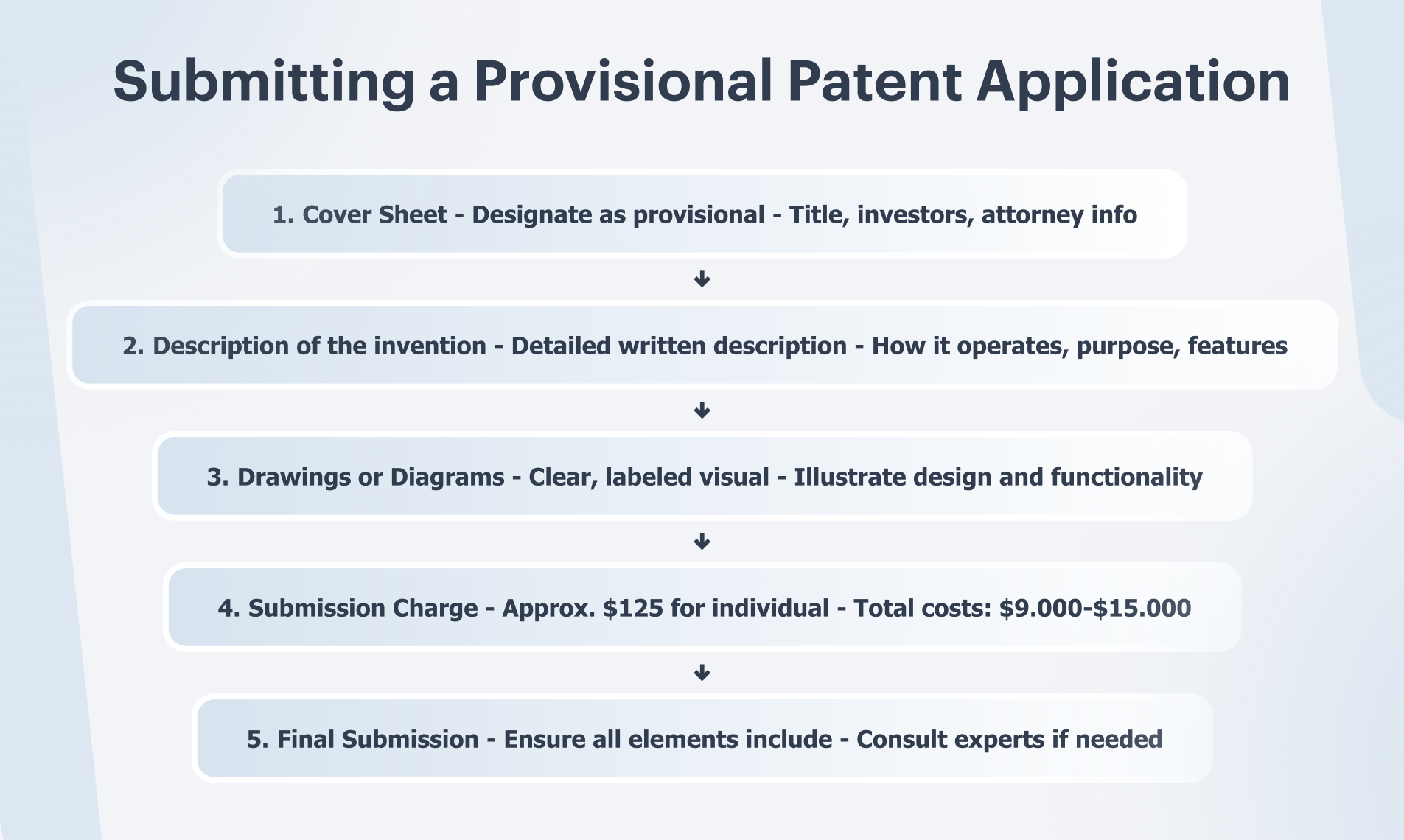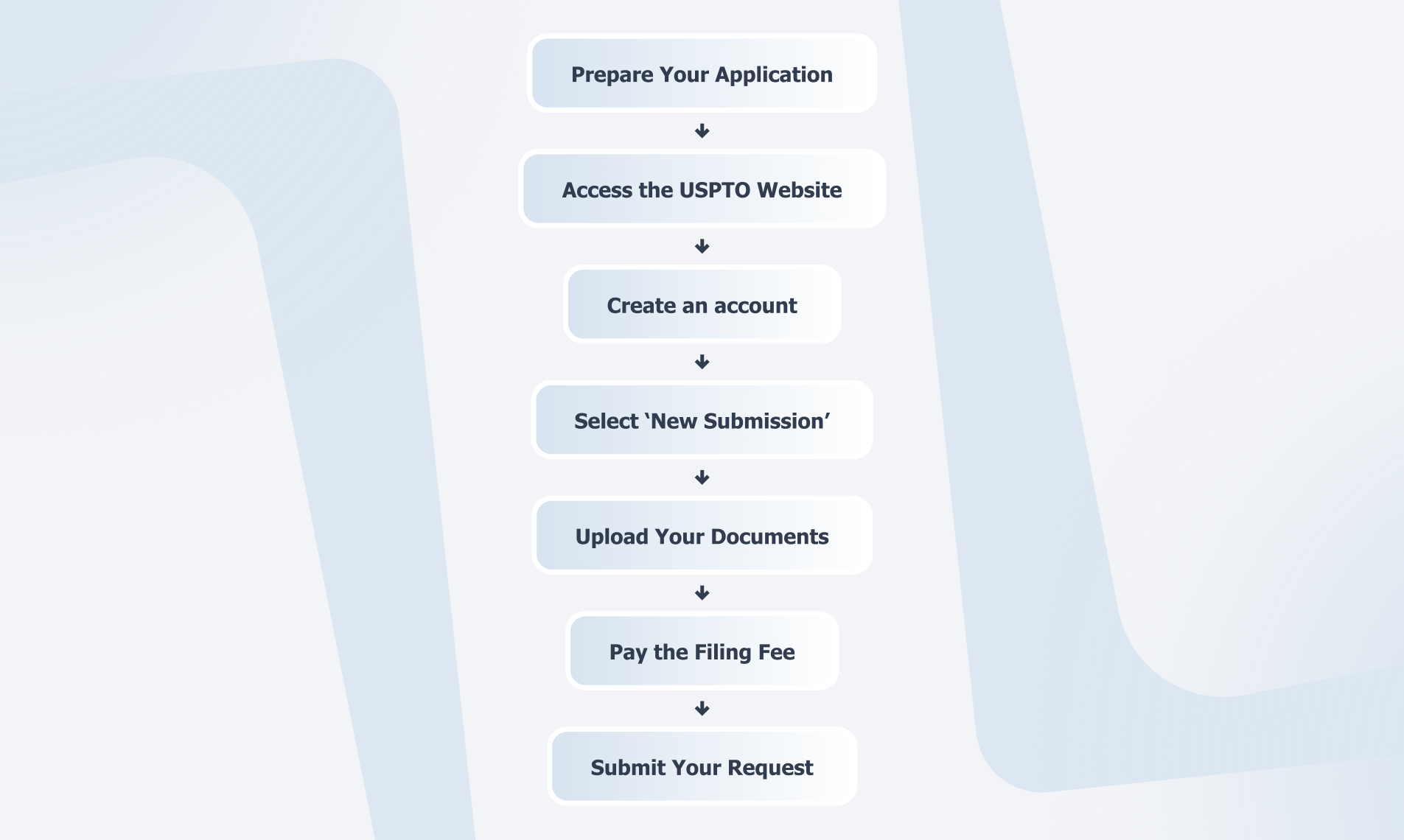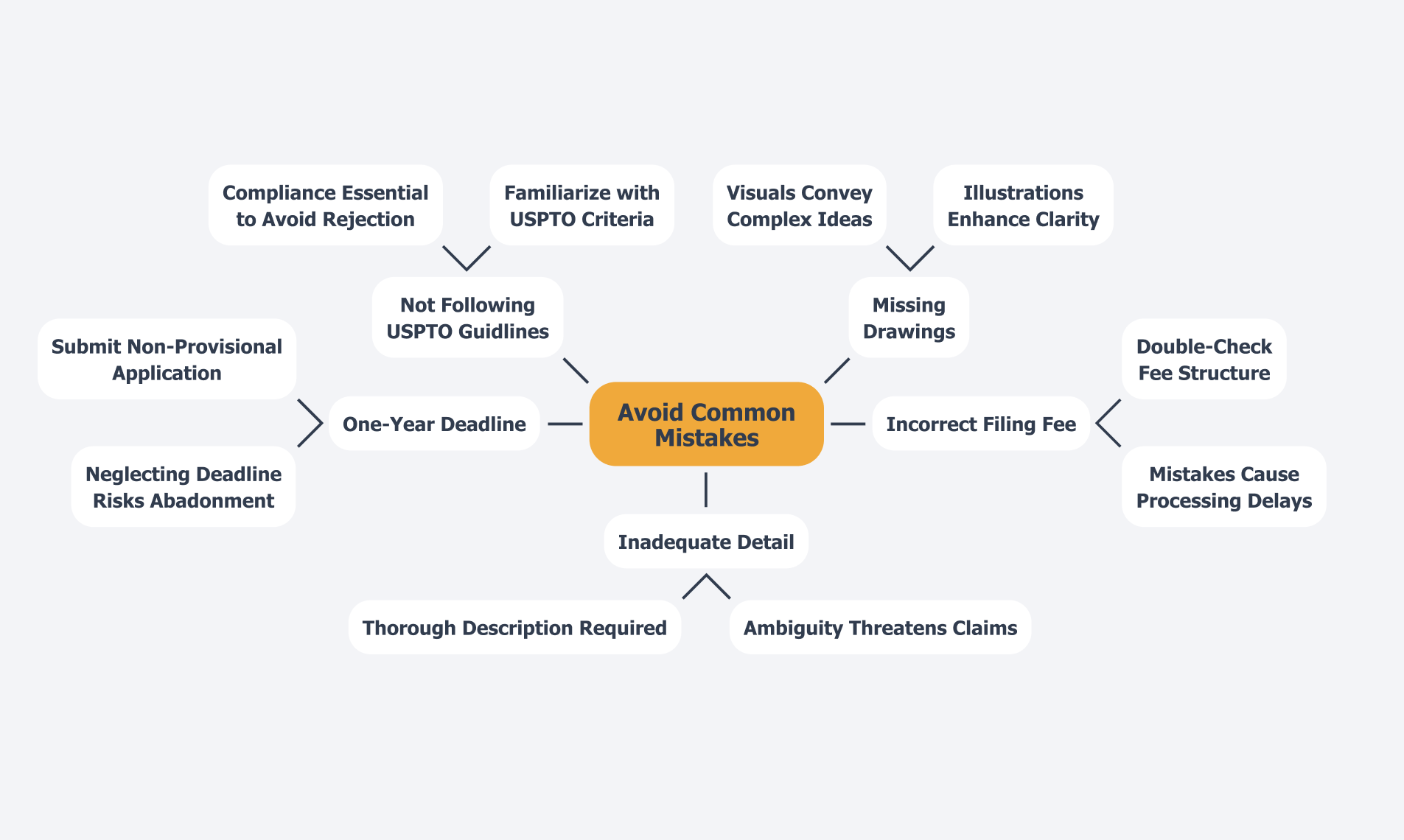Overview
The article delineates the critical steps for effectively filing a provisional patent application (PPA), underscoring the necessity of thorough preparation and strict adherence to USPTO guidelines. It elucidates the essential components involved, identifies common pitfalls to avoid, and outlines the transition process to a non-provisional application. By illustrating how strategic planning and meticulous execution can significantly enhance the likelihood of securing intellectual property rights, the article serves as a valuable resource for those navigating the complexities of intellectual property management.
Introduction
In the competitive realm of innovation, securing intellectual property is paramount for inventors aiming to safeguard their creations. One highly effective strategy is the utilization of provisional patent applications (PPAs), which provide a streamlined approach to establishing a priority date without the complexities associated with a full patent application. This article explores the significance of PPAs, detailing their advantages, essential components, and the filing process, while also pinpointing common pitfalls to avoid. As the landscape of patenting continues to evolve, grasping how to effectively leverage provisional applications can empower inventors to navigate the intricacies of intellectual property protection with confidence.
Understand Provisional Patent Applications
A temporary intellectual property request (TIR) serves as a strategic asset for creators, allowing them to secure an early submission date for their invention without the complexities associated with a non-temporary request. In contrast to its counterpart, a provisional patent application (PPA) is more efficient and cost-effective because it does not require formal claims, an oath, or a declaration. By submitting a provisional patent application, inventors achieve ‘patent pending’ status, which can effectively deter competitors and provides a crucial year to refine their invention and conduct market research before filing a comprehensive non-provisional application.
The significance of provisional patent applications is underscored by recent statistics indicating that approximately 70% of inventors choose this route, acknowledging its advantages in safeguarding intellectual property. In 2022, provisional intellectual property submissions constituted a substantial share of overall filings, reflecting an increasing trend among startups and established companies to file early and frequently. This proactive strategy is essential, particularly in sectors such as biotechnology, which accounted for 15% of total USPTO filings that year, underscoring the sector’s pivotal role in scientific and medical advancement. Additionally, prominent areas for filings included digital data processing/application, communication and broadcasting, and artificial intelligence, which together represented 24% of total submissions, highlighting the growing importance of digital technologies and AI in driving innovation.
Experts emphasize that the rise in intellectual property litigation and associated costs underscores the necessity for strategic planning and resource allocation in the registration process. As one attorney noted, “The increase in litigation and the significant expenses related to acquiring intellectual property highlight the necessity for strategic planning and resource distribution in the registration process.” Intellectual property attorneys advocate for the use of provisional patent applications as a means to protect innovations while granting inventors the flexibility to enhance their creations before finalizing a complete submission. Case studies illustrate that companies effectively utilizing provisional patent applications have successfully navigated the complexities of patenting, leveraging the initial submission to secure funding and strengthen their market position.
As we look ahead to 2025, the importance of temporary intellectual property requests continues to grow, establishing them as a vital element of the intellectual property landscape. As inventors increasingly recognize the benefits of filing a provisional patent application, they position themselves to capitalize on their innovations while mitigating the risks associated with patenting. It is imperative for inventors to adopt a proactive approach to safeguard their innovations, ensuring they are well-equipped to navigate the patenting process.

Identify Requirements and Components
Submitting a provisional patent application requires careful consideration of several essential elements to ensure a seamless procedure. The key components include a provisional patent application among others.
- Cover Sheet: Clearly designate the request as a provisional patent application. Include the title of the invention, the names and addresses of all inventors, and any attorney information if applicable.
- Description of the Invention: Provide a comprehensive written description detailing how the invention operates, its intended purpose, and its unique features. This description must be sufficiently detailed to enable someone skilled in the relevant field to replicate the invention.
- Drawings or Diagrams: If applicable, include clear and labeled drawings that illustrate the invention. These visuals should enhance understanding and provide a thorough view of the invention’s design and functionality.
- Submission Charge: A submission charge is necessary to process the request, which is approximately $125 for individual inventors. It is crucial to note that the total expense of acquiring intellectual property typically ranges between $9,000 and $15,000, encompassing submission, legal assistance, and ongoing maintenance. Ensure your payment accompanies your submission of the provisional patent application to prevent processing delays. In 2025, the average submission fees for provisional patent applications remain stable, reflecting the ongoing adjustments made by the US Patent Office based on demand and operational costs. By incorporating all these elements, inventors can significantly reduce the risk of delays and complications during the provisional patent application process. Consulting with intellectual property experts, as highlighted in the case study titled ‘Consultation for Intellectual Property Guidance,’ can provide tailored advice and assist inventors in selecting the most cost-effective route to securing their rights. Staying informed about the US Patent Office’s fee schedule is also essential for understanding the significance of the application fee.

Follow the Filing Process
To successfully file a provisional patent application, follow these essential steps:
- Prepare Your Application: Compile all necessary documents, including the cover sheet, a detailed description of your invention, and any required drawings.
- Access the USPTO Website: Navigate to the United States Patent and Trademark Office (USPTO) website and visit the Patent Center.
- Create an Account: If you do not have an account, sign up on the USPTO website to enable electronic submission.
- Select ‘New Submission’: Once logged in, click on ‘New Submission’ and choose ‘Utility Provisional’ from the available options.
- Upload Your Documents: Follow the prompts to upload your cover sheet, description, and drawings, ensuring all files meet the formats specified by the USPTO.
- Pay the Filing Fee: Complete the payment for the filing fee and keep a record of the transaction for your files.
- Submit Your Request: Carefully review all information for accuracy and completeness before submitting your request. Upon submission, you will receive a confirmation email containing your reference number.
By adhering to these steps, you can ensure that your provisional patent application is submitted accurately and efficiently. Notably, over 75% of application submissions pertain to technology-related inventions, underscoring the importance of an efficient filing process in today’s innovation-driven landscape. Furthermore, in 2023, preparations for medical, dental, or toilet purposes (A61K) accounted for 11,042 inventions, illustrating the diverse range of creations being registered.
Understanding the role of examiners, who number over 8,500 at the USPTO, is vital for effectively navigating this process. Their expertise ensures compliance with essential standards, which is crucial for a successful submission. As Sheldon, a skilled expert at the USPTO, stated, “Comprehending the intellectual property system is crucial for inventors to manage the intricacies of submission.”
It is also important to recognize that the average duration required to submit a temporary intellectual property request can vary. Recommended procedures include verifying all documents for thoroughness and accuracy before submission. By following these guidelines, you can significantly enhance your chances of a successful filing.

Avoid Common Mistakes
To enhance the likelihood of a successful provisional patent application, it is essential to avoid several common mistakes:
- Inadequate Detail: A thorough and detailed description is crucial. Ambiguous descriptions can threaten your capacity to assert your invention later, as a thoroughly documented submission enhances your stance for pursuing a nonprovisional patent.
- Disregarding the One-Year Deadline: A provisional patent application is only valid for one year. It is crucial to submit a non-provisional request within this timeframe to preserve your priority date, as neglecting to do so can result in the abandonment of your submission.
- Missing Drawings: Incorporating illustrations can greatly improve the clarity of your submission. If your invention can be illustrated, ensure that these visuals are part of your submission, as they help convey complex ideas more effectively.
- Incorrect Filing Fee: Always double-check the fee structure to ensure the correct amount is submitted. Mistakes in fee submission can result in processing delays, which may endanger your timeline.
- Not Following USPTO Guidelines: Get acquainted with the USPTO’s criteria for a provisional patent application. Following these guidelines is essential; failure to comply can lead to the rejection or abandonment of your submission.
Statistics suggest that a substantial proportion of temporary applications are abandoned, highlighting the necessity of steering clear of these frequent errors. By being mindful of these pitfalls, inventors can significantly improve their chances of a successful filing. As mentioned by seasoned creators, “It’s essential to be meticulous and exact, as any overlooked details could endanger your intellectual property rights later.”
Furthermore, case studies, like In re Packard, highlight the significance of clarity in intellectual property claims, emphasizing the necessity for thorough and accurate drafting to prevent rejections due to vagueness. Consulting with intellectual property lawyers can also provide valuable advice on preparing a protection request and ensuring it meets necessary criteria.

Transition to Non-Provisional Application
Transitioning from a provisional patent application to a non-temporary patent filing is essential for securing patent protection. Here’s a streamlined approach to ensure a successful transition:
- Evaluate Your Invention: Review any modifications or enhancements to your invention since submitting the temporary document. Update the description and drawings accordingly to reflect these modifications.
- Prepare the Non-Provisional Submission: This submission must include formal claims, a comprehensive description, and any necessary drawings. Ensure compliance with all USPTO requirements to avoid delays.
- Submit Within One Year: It is essential to submit the non-provisional request within one year of the initial request’s submission date to retain the advantage of the earlier submission date. Statistics indicate that prompt submission of a provisional patent application significantly enhances the likelihood of successful patent approval, with a remarkable transition rate from provisional to non-temporary submissions.
- Claim Priority: Clearly assert priority to the provisional submission in your non-provisional request. This step is crucial for maintaining your initial submission date and safeguarding your invention.
- Pay the Required Fees: Be prepared for the increased costs associated with submitting a non-provisional request, which can average around $6,000 for moderately complex inventions. This expense underscores the significance of economical intellectual property drafting services.
By adhering to these steps, inventors can facilitate a smooth transition and protect their intellectual property rights. Notably, concerns have been raised regarding the financial implications of multiple temporary submissions, as highlighted by Mohammed Alhajeri, emphasizing the necessity for thorough planning and prompt actions in the intellectual property process. As Judge Giles Rich remarked, ‘The life of an intellectual property solicitor has always been a hard one,’ reflecting the ongoing challenges in the field. Successful instances of non-provisional submissions following a provisional patent application illustrate the effectiveness of this approach, reinforcing the importance of strategic management in intellectual property. Furthermore, clearer communication regarding patent application types is essential for corporate IP managers to navigate the complexities of the patent system.
Conclusion
Provisional patent applications (PPAs) are pivotal in the innovation landscape, offering inventors a strategic method to establish a priority date while simplifying the patenting process. By choosing a PPA, inventors gain essential time to refine their inventions and conduct market research, all while enjoying the protective status of “patent pending.” With significant statistics reflecting the increasing preference for PPAs, understanding their advantages is crucial for anyone aiming to safeguard their intellectual property.
Filing a successful PPA demands meticulous attention to critical components such as:
- A comprehensive description of the invention
- Accompanying drawings
- Compliance with filing fees
Avoiding common pitfalls—such as insufficient detail, missed deadlines, and non-compliance with USPTO guidelines—can greatly enhance the likelihood of a successful application. Furthermore, transitioning from a provisional to a non-provisional application within the required timeframe is essential for preserving patent rights.
As the patent landscape evolves, the significance of PPAs continues to grow, empowering inventors to navigate the complexities of intellectual property protection with confidence. By leveraging the advantages of provisional applications, inventors not only protect their innovations but also strategically position themselves within a competitive market. The proactive approach of utilizing PPAs highlights the necessity of strategic planning in the patenting process, ultimately fostering a culture of innovation and creativity.
Secure Your Innovation with a Provisional Patent Application! Start now with iPNOTE and simplify your path to patent protection.
Frequently Asked Questions
What is a temporary intellectual property request (TIR)?
A temporary intellectual property request (TIR) is a strategic asset for creators that allows them to secure an early submission date for their invention without the complexities of a non-temporary request.
How does a provisional patent application (PPA) differ from a TIR?
A provisional patent application (PPA) is more efficient and cost-effective than a TIR because it does not require formal claims, an oath, or a declaration, allowing inventors to achieve ‘patent pending’ status.
What advantages does filing a provisional patent application provide?
Filing a provisional patent application provides ‘patent pending’ status, deters competitors, and gives inventors a crucial year to refine their invention and conduct market research before filing a non-provisional application.
What percentage of inventors choose to file provisional patent applications?
Approximately 70% of inventors choose to file provisional patent applications, recognizing their advantages in safeguarding intellectual property.
What sectors showed significant activity in provisional intellectual property submissions in 2022?
The biotechnology sector accounted for 15% of total USPTO filings, while digital data processing/application, communication and broadcasting, and artificial intelligence together represented 24% of total submissions.
Why is strategic planning important in the registration process of intellectual property?
Strategic planning is crucial due to the rise in intellectual property litigation and associated costs, emphasizing the need for resource allocation in the registration process.
What role do provisional patent applications play in a company’s strategy?
Provisional patent applications allow companies to protect their innovations while providing flexibility to enhance their creations before finalizing a complete submission, which can help secure funding and strengthen market position.
What are the essential components required for submitting a provisional patent application?
The essential components include a cover sheet, a detailed description of the invention, drawings or diagrams if applicable, and a submission charge.
What is the typical submission charge for a provisional patent application?
The submission charge for a provisional patent application is approximately $125 for individual inventors.
What is the total expense range for acquiring intellectual property?
The total expense for acquiring intellectual property typically ranges between $9,000 and $15,000, which includes submission, legal assistance, and ongoing maintenance.
How can inventors reduce the risk of delays during the provisional patent application process?
Inventors can reduce the risk of delays by incorporating all essential elements into their application and consulting with intellectual property experts for tailored advice.






